Any inaccuracies and creations herein are on my behalf. Italics are my best attempt at recording verbatim Master Chen’s teachings, everything else is my best attempt at describing them.
Although we live in a 4D world (space-time), let’s use a 2D object to explain some fundamentals – the hinge. What are the requirements of the design? To keep one thing stationary whilst allowing another thing to swing. One application is a door.
- Establish a fixed reference. A rope dangles in front of you. How? Test it by various means and you will deduce that through swinging on it it has to be somehow swiveling at a point above you – probably a ceiling. Using the door example, let’s decide the door frame is fixed and the door moves. Note that we could say the door is the fixed reference and the frame is the swinging object. Must create opposites. If you have two opposing forces on your body you have taiji.
- Establish your axis. Decide the orientation of the axis of rotation. Using a conventional door, it should be between the frame and door, typically perpendicular to the horizon, but it could be parallel or any orientation. You must choose.
- Make the connection. Steps 1 & 2 must be irrevocably established in order, no going back. All that is left is to connect the door to the frame using two brackets and a pin – a hinge – with fasteners.The elegance lies with the pin since it is the simple piece which converts all other pieces – the door and frame – to circular movement. Without a pin the simple design requirement can never be fulfilled. We could hire someone, or millions of people, to mimic the swinging action of the door, but it will always be linear movements in the end since this is how we are programmed to move. When observing the door moving, the pin never moves. Movement through no movement. Through rotation, the outside can move but the inside does not. Why? Caps on either end prevent the pin from axially moving due to torque; being fastened to the door restricts horizontal movement in one direction and being fastened to the frame adds another horizontal restriction. The lubricant, acting as the buffer, ideally allows frictionless contact between the pin and the brackets. Since something has to give in a system, the buffer or lubricant has to eventually be replenished. With some reflection, a plethora of deductions can be made from this simple analogy and are hopefully helpful to our practice of taijiquan. In our method we want all movements to be based on the principle behind the hinge. This is a matter of fact i.e. not what our mind thinks but what our body actually does. We think we do not move, but [in the beginning] we can only do one or the other. When you get better, you can truly not move one point and move another. Psychologically, when we do things ourselves we tend to think we are doing what we are told, but if you could see yourself you would see otherwise. This is why you have to train regularly, occasionally require a good eye watching you and incorporate various apparatus into your practice. In this way your body eventually memorizes the unfamiliar movements. As mentioned, if there were no caps the pin would eventually lift upwards. This means that as it rotates, the force has to go somewhere. It is prevented from going laterally, therefore it wants to move longitudinally. We essentially want all our movements in our body to follow suit: we want to do a true rotation about an axis to make the force travel along the longitudinal axis while keeping the rotation in one place. Start with clear distinct axes on major body parts; the biggest would be your centre line: energy should feel like it is going (torquing) downwards. If one point were truly restricted from moving in space, you would find it very difficult to move – this is one way to know you are on the path to correct movement. A good practice is to free\empty your mind on a daily basis. We have to have some type of regimen to do this since our mind will always revert back to what it wants to think. Since our movements are based on the hinge, it would make sense to look at a physical hinge to refresh or enhance our understanding of the principles of the method. We have to train our minds to understand that the door and the frame never [locally] move: if a dot was placed on the door and one on the frame, the dots will always be in the same place with respect to the surface they lie on, regardless how much net gain or temporal change occurs in the [global] system. Another way to say it is dynamism influences change in the system, but the static characteristic is always constant. Ideally we want to be a fixed frame with a fixed hinge inside us, using only pure rotation to move the door or any object. If one uses a knife as a weapon, one might think the knife is moving, but in reality the knife never moves – we are moving it. It is an argumentative statement to say otherwise. In this way, if we can truly not move one point or establish a fixed reference on our body, it’s as if we had a rock or knife in our hand. In establishing this quality on your body, the highest and most powerful are nine [joint-to-joint] relationships or stretches: five on upper half of body, three on lower half and last is action or intent. Commonly after establishing three points, the opponent will float. Taiji came about from observance of nature. We only discover properties of nature and therefore they are the ‘truth’. In our 100,000 human year history, the recent discovery of rotation has changed our civilization at a faster rate than ever. A plane is largely able to fly since we reached a level of precision necessary for a propeller to rotate necessary for adequate propulsion. Many of our mechanical feats are attributed to rotating parts. As you gain mastery and precision – more discretized parts and effective use – of your body, you will be able to do seemingly magical things to the common eye, yet they are purely mechanical. Think how any new discovery, accidental or not, seems magical in it’s nativity yet we can often offer some sort of rational explanation eventually. The only part we cannot explain in taiji is the intent (ninth) point. Distance is distortion of space, therefore pure rotation has no distance felt. When one can achieve a true rotation, the effect is tactically magical to the untrained and yet the process is entirely mechanical. Hong based movements on this characteristic – it looks like he is not moving much, but he is in fact creating zero distance throughout his body via highly precise rotations. The reason he called it “Practical Method” was to emphasize the ephemeral nature of taijiquan, meaning there are no mystical things happening. In theory, if anything in nature achieved pure rotation it would encompass the universe since it would occupy no space.
- Training apparatus for front knee:
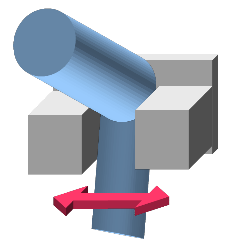 Two blocks affixed to wall to prevent lateral movement of knee while doing circles
Two blocks affixed to wall to prevent lateral movement of knee while doing circles - Zhuan Guan (Turning over of the Joint) See Video
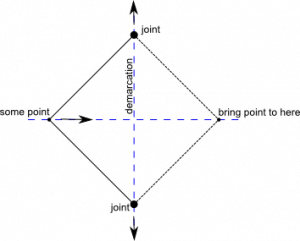
- Circles\Alignment:
- Elbow in
- Don’t move front knee
- Activate elbow, not hand
- Pull elbow towards rear knee
- Rotate at shoulder
- Keep movements clear. For example, in with elbow means just in with elbow, not anything else. Turn with waist does not mean draw the hand with your body; in observing Master Chen, his elbow in fact starts to rise upwards in a curve while the hand is stationary.

- To prevent the natural tendency of leaning forward, practice leaning back a tiny bit. We want to naturally stay upright and keep centre locked
- Head must be behind front kua, otherwise you lengthen the distance of [your] kua to [partner’s] kua. You should always feel like you are in a shoveling pose.
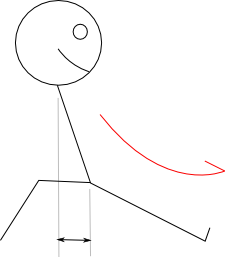
- Push baikhui up and elbow down
- Hand out
- Don’t move rear knee
- Occurs as soon as they are off balance
- Power path vs. physical hand path:
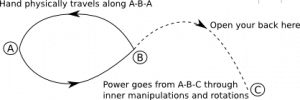
Keep front sticking while back opens
- Rear of body can never go forward and visa versa.
- Not on, not off
 If you raise this line off the ground, it should lie behind the front knee and in front of rear knee. If you wobble at all with the knees, the line distorts. Your goal is to always keep this line. Incorrect movements in other parts of your body can throw this off, therefore move as much as possible without moving this line in space.
If you raise this line off the ground, it should lie behind the front knee and in front of rear knee. If you wobble at all with the knees, the line distorts. Your goal is to always keep this line. Incorrect movements in other parts of your body can throw this off, therefore move as much as possible without moving this line in space. - Swinging Rope
 Circle is produced from fixed point and tight connection(s).
Circle is produced from fixed point and tight connection(s).
- Elbow in
- Stance
- Thin vs. Thick
 Master Chen used this example to highlight reproducibility i.e. how accurate can you reproduce the correct foot placement on command?
Master Chen used this example to highlight reproducibility i.e. how accurate can you reproduce the correct foot placement on command? - Use the heel to act (power) against ground. Master Chen showed example of lifting his toes of both feet off the ground while still being able to pin, launch and control.
- Thin vs. Thick
- Finger/Hand:
- Tip of middle finger does not move from a dot on the 45 degree line

- The middle finger is kept straight with respect to wrist-elbow line, but tips of other fingers are skewed to form a curve. The end result is a ‘towel twisting’ hand that resembles a turbine blade. This configuration creates an internal spiral from the elbow to hand without twisting skin.
- Fingers can never face yourself. Like poking yourself with a knife.
- Tip of middle finger does not move from a dot on the 45 degree line
- Vertical versus Horizontal:
- Vertical = longitudinal or longer dimension; all body members are vertical Horizontal = lateral or shorter dimension
- All movements need to move along vertical, never deviate horizontally
- Any 2 points on body which separate along vertical produces peng. Should be able to increase the distance between two hands placed anywhere on body
- Imitate a ball, not a shape. Any object spun will be a ball since it has some axis of rotation. Roundness therefore is in the actions, not in the shape, which means the joints must be ‘acted’ appropriately. In this way, energy is not trapped in the joints and increases mobility. When movements are vertical, you move energy, otherwise you move shapes.
- Towel twisting
- No flexing in arms
- If you had kua-foot sticks, you would feel these rotate
- Kua has to be like sitting on floor e.g. someone should be able to push as hard as they want on kua without you moving at all
- There is a ‘sweet spot’ in the stance where all spaces and gaps are closed/filled in the body. Need this feeling in push hands.
- Intent is your imagination touching on something true, anything else is a monkey on a horses back. In taiji, don’t anticipate. Knowing the attack will always be directed at you, you should already know the end result, thence don’t worry about the process. Don’t look for it, just accept they are coming for you. Kill your mind and accept the system. In the quest for testing taiji authenticity, use taiji standards as opposed to fighting. Both are systems with different rules. For instance, can they truly make a lever on their body? In Taoism, nothing is wrong, but it might not be relevant. If the teacher is teaching one principle, a student not staying on topic is not wrong, but their question is irrelevant. Yin/Yang is like a teeter-totter: opposites with fixed point of rotation. Transmission: stubborn; what you are told you do. As a beginner, stay closed-minded; don’t visit other schools until you understand and can do the principles. Energy transfer is like a pin ball machine: using rotations, you keep the energy in play (trapped) and redirect as you wish. There are two schools of fight: loose and hit which is likened to more pure boxing; don’t move and rotate which is the basis of Chen style. To clear: distinct movement against non-moving spot. Spiral: rotation + length; interaction of [minimum] two points; highest interaction is five points. 3-joints in all of taiji e.g. wrist-elbow-shoulder
Sink: energy goes down, not physically drop. Towel twisting is likened to lifting a bucket of water out of a well: the move is incorrect if you physically use the back to lift the bucket out since eventually you will injure yourself. Keeping yourself open and stable allows you to lift the bucket out safely. Taoists believe water is life. The more you practice your body (joints) fill with water. Since the kidneys represent water, keeping stable but activating them is good for health. Reproducibility == ability (synonymous to precision); a good measure of mind-body connection. For instance, can you pull someone with your elbow and not with strength or anything else? If yes, you are precise. Efficiency = action on their centre. Move efficiently. Linking = moving as one. Don’t do this. Softness in taiji is like two steel balls encased in a tight box with oil: balls feel smooth, soft and slippery, yet they are very strong. The adage “like steel wrapped in cotton” is imprecise since cotton is ‘soft’, yet it is something you can grab. Therefore cotton has nothing to do with ability. Everything in nature is hard; the outside is always harder than the inside. Never be loose in training since this does not agree with nature. Be strong without hurting yourself. Be tight like a balloon: don’t be rigid but be full. If you rotate, you transmit energy. Energy transference is proportional to ability to rotate.
- Push Hands
- Do not push or lift with hands; fill empty gaps and use waist. Like a snake shedding it’s skin, I observed Master Chen has an extraordinary ability to keep integrity in his core whilst very quickly slipping in to fill or plaster the gaps on your body. At a higher level, one does not need to do this; on contact he is on your spine. Energy must pass through the spine. Crude or beginner 1-2-3 process:
- Squeeze. All spaces should be occupied and all gaps filled. Keep kua-kua.

- Lock. Maintain your contact points; create a tight downward torque through their body – they should feel like they are being screwed into the ground.

- Rotate.
 In order to do this step we must ‘cut’ (sink along established line) with the shoulder closest to partner. Shoulder never rises or lifts, it always sinks in every move. Your movement must be kept proportional: when sinking with shoulder and the feet are planted, you should be rotating about a fixed dot roughly in the dantien area – this is a hinge. A tripod is 3-dimensional since it has 3 legs to keep it stable. Being bipedal, we are 2-dimensional like paper therefore there is always a missing third leg. When pushing, always track for that missing leg and rotate towards this spot whilst keeping steps 1 & 2.
In order to do this step we must ‘cut’ (sink along established line) with the shoulder closest to partner. Shoulder never rises or lifts, it always sinks in every move. Your movement must be kept proportional: when sinking with shoulder and the feet are planted, you should be rotating about a fixed dot roughly in the dantien area – this is a hinge. A tripod is 3-dimensional since it has 3 legs to keep it stable. Being bipedal, we are 2-dimensional like paper therefore there is always a missing third leg. When pushing, always track for that missing leg and rotate towards this spot whilst keeping steps 1 & 2.
- Squeeze. All spaces should be occupied and all gaps filled. Keep kua-kua.
- The lever handle has to be longer than the lifting end to produce mechanical advantage. That’s why we want to shorten the distance (close the gap), lengthen everything behind it and use the contact point(s) for pivoting.
 The lever or long end is made from the connections made from the rear heel to the contact points: the more connections made the longer the lever. Likewise, mechanical advantage increases with additional degrees of freedom (linkages) added. Drawing a line through chosen contact points, a temporary rotation axis is created. Similar to the hinge, this axis must now remain locked in space. Using your connected lever, power from rear foot and use the temporary axis to spin short end (partner) out.
The lever or long end is made from the connections made from the rear heel to the contact points: the more connections made the longer the lever. Likewise, mechanical advantage increases with additional degrees of freedom (linkages) added. Drawing a line through chosen contact points, a temporary rotation axis is created. Similar to the hinge, this axis must now remain locked in space. Using your connected lever, power from rear foot and use the temporary axis to spin short end (partner) out. - Goal is kua to kua i.e. get very close. Your kua is the tip of your ball (rotation), therefore that is ideally what you want to physically touch to his kua. As skill goes up, kua to kua distance increases and there is less physical contact.
- Focus on one point at a time e.g. if they are not moving points on their legs, try to move one point along an intended line; the minute you simultaneously focus on the upper body you will lose it.
- Strive for efficient movement.
- Do not let energy be redirected away from partner. Always trap it so as to redirect again somewhere back on them through their spine.
- By matching their energy at the contact point, try to neutralize their power to find the ‘tipping’ point such that an iota of energy will topple them. Simple test/example: two people stand opposite each other holding an upright book with their finger tips. One person mimics the movements and energy of the partner so the book will stay upright. The moment the energy is not matched the book will fall.
- Create demarcation line with contact points. If you only then push, nothing happens to that line.
- Separate the line. This is where you find the tipping point or border line.
- Push hands, not hands push. Use the border line as the axis of rotation such that any [perpendicular] force used – on their part or yours – creates pure torque. It is easy to tell if you are doing it incorrectly if there is still any fight or push left.
This process only comes through yilu and push-hands experience. Similar to skewing meat on your own rotisserie.
- Do not push or lift with hands; fill empty gaps and use waist. Like a snake shedding it’s skin, I observed Master Chen has an extraordinary ability to keep integrity in his core whilst very quickly slipping in to fill or plaster the gaps on your body. At a higher level, one does not need to do this; on contact he is on your spine. Energy must pass through the spine. Crude or beginner 1-2-3 process:
- Yilu
- Create different rhythms on your body in any movement to create relationships. Do not link.
- 7″ knife never moves through the entire form. Measured from outside of pinkie knuckle.
- Punch covering hand
- Do not pull right kua or right shoulder back before punch
- Right palm to ceiling before punch
- Form fist and extend arm out with palm still to ceiling
- Lengthen everywhere in body without moving for last inch
- Any established sticks, imaginary (not visible) or physical, on your body or in pushing never move. In the beginning, don’t worry about all the non-visible sticks, just focus on keeping the ones in your body or around your body. Start big i.e. hand-foot stick, then go smaller i.e. shoulder-kua stick.
- Doing the form repeatedly trains the body to keep strength and structural integrity regardless of the onslaught like a door jam.
Anyhow folks, I can write a whole deal, but believe me I can’t do a lick of any of it, starting with step 1 🙂

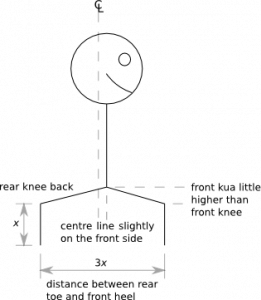


{ 11 comments… read them below or add one }
WOW!
Hi Allan,
Great notes!!! thanks for sharing.
Regards
Nice Notes!!!
computer graphics and all….thanks for taking the time to share those notes!
Thank you Allan. This will help me to digest the teaching of Master Chen’s teaching.
Looking forward to see you guys in the next session.
Paul
Allan, Thank you for your time to prepare this. It is a great job.
Steve Man
Hey Allan, I love your notes. See you at the next session.
Hugo
These notes are fantastic! Excellent detail.
This is what I have learned in Hong Kong workshop too! Thanks for your notes.
Allan, excellent notes with nice graphics! You should be our official note taker in Toronto.
These are impressive notes, you must have a photographic memory! Thanks, still trying to understand it all. Very helpful.